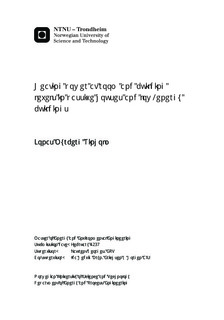| dc.description.abstract | This master thesis investigates the Norwegian standard for calculating necessary power demand, NS-EN 12831:2003- Varmesystemer i bygninger - Metode for beregning av dimensjonerende effektbehov. In that context, it is also investigated how power demand affects heating systems financially and environmentally, but also in terms of comfort and indoor air quality.
Improved energy efficiency are leading to a reduction in the power demand for heating purposes in buildings. However, there are few guidelines for how the power demand for heating should be calculated at room level or at building level and correspondingly little documentation on thermal comfort and power demand in low-energy and passive houses.
Dimensioning heating systems correct is very important for comfort, energy and finance. Net power demand over the year should determine the distribution between base load and peak load. It is crucial that the estimated power demand correspond to real power demand in order to find the optimal distribution. Gross power demand is the basis for net power demand. A more realistic net power duration curve leads to a more profitable distribution between base load and peak load. If a safety margin is desirable, one should install an additional peak load, which is a cheap investment. That will not affect the operating costs appreciable, as it hardly will be in use.
Buildings are complex and there could be many reasons why real power consumption do not match the calculated and intended power demand. Larger heat loss than calculated may be a result of an inaccurate calculation method, poor quality of the work in the construction phase and that the building is used in a different way than intended.
Choosing a reasonable ventilation airflow at design conditions is important. In the winter, there is rarely any cooling demand, and the necessary ventilation airflow only depends on the airflow needed to ensure good indoor air quality.
In passive houses and low-energy buildings it is cheaper to maintain good indoor air quality as the heat transfer coefficient is low and the heat recovery in the ventilation system has good efficiency. It would seldom make financial sense to reduce indoor air quality, neither thermal nor atmospheric. Especially in commercial buildings, where a small percentage drop in performance would constitute a major cost in terms of wages to non-productive time.
The main improvement potential to the Norwegian standard, NS-EN 12831:2003, found in this master thesis is:
One of the most obvious potentials for improvement is to include internal loads as lighting, computers and people to reduce the power demand. Especially at building level were one use a central heating system, in which the need of installed capacity will be reduced. At room level, one should be more careful and only include internal load that most certainly occurs at design conditions. The sum of the power demand at room level might then be larger than power demand at the building level, but it includes the uncertainty of using different rooms at different times.
The calculation method for infiltration, particularly mechanical infiltration, have a potential for improvement. The American standard, ASHRAE 2013 takes into account that the airflow is not linear with the pressure difference across the building envelope. NS-EN 12831:2003 does not, but adds mechanical ventilation airflow as an addition, distributed by permeability.
Heat release from ventilation fans and heat loss due to transmission and leakage from ducts are included in ASHRAE 2013, and is an improvement potential of the Norwegian standard. Heat release from the ventilation system in the investigated building is estimated to about 4,8kW at design conditions, which is 6,7% of calculated design power demand in the ventilation system.
Clever control of the installed power is also a possibility. It is possible to drop night setback during the coldest periods or exploit installed capacity of domestic hot water.
The Swedish standard, FEBY 12, seems to have the most detailed approach of how to choose design outdoor temperature. One finds the number of days in the n-days mean temperature method by calculating the heat storage in the actual building. FEBY 12 provides a method of grading the choice of design outdoor temperature based on heat storage in the building.
Several buildings should be examined in order to conclude that the recommendations given in this thesis are the best options. It will be much easier having a simpler control principle than in the investigated office in this master thesis. Being able to play with the control of the building will also make it a lot easier to eliminate sources of error. Nevertheless, the main principles found in this master thesis should be considered reliable. | |

